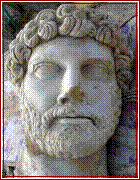
|
To contact us: |

|
Hadrian returns to Britain |
|
The British Museum’s major exhibition from 24th July to 26th Oct 2008 will focus on the Roman Emperor Hadrian. Hadrian: Empire and Conflict, supported by BP, will be the first major show dedicated solely to the life and legacy of Hadrian who ruled the Roman Empire at its height between AD117 – 138. Bringing together over 180 loans from 31 countries – from Italy to Georgia, Israel to Newcastle – the exhibition will display dramatic sculpture, exquisite bronzes and architectural fragments, many of which will be seen for the first time in the UK. The exhibition will bring the contradictions in Hadrian’s personality and reign into sharp focus: a military man and homosexual, he combined ruthless suppression of dissent with cultural tolerance. When Hadrian came to power, the Roman Empire was larger than the present EU, with a unified language, currency and administration. His first act on becoming emperor on the death of his fellow Spaniard, Trajan, was to recognise the issue of imperial overreach – with telling present-day resonance, he took the decision to withdraw Roman troops from Mesopotamia, modern day Iraq, and he ordered the wall which now bears his name to be built to divide England and Scotland. On an individual level, Hadrian was famed for his interests in architecture and Greek culture. He took a young Greek lover, Antinous, who accompanied him on his travels around the empire. Hadrian travelled extensively throughout his reign and met more of his people than any other emperor before him. The exhibition will provide fresh perspective on Hadrian’s life and will reassess the extensive legacy of this famous emperor. A stunning bronze head of the emperor from the 2nd century AD, will travel to both ends of Hadrian’s Wall. The head is one of the rare surviving bronzes from Roman times and has never left the British Museum since its discovery in the River Thames in 1834. It is an almost unique survival – large bronze statues were often melted down, but its submersion kept it from this fate. The underwater silts of the Thames also protected the patina on the head meaning it is particularly well preserved. The head comes from a statue, one and a quarter life size, that may have been erected in a public space in London in AD122 to commemorate Hadrian's visit to Britain. ‘The Face of an Emperor: Hadrian inspects the wall’ will be seen in Tullie House, Carlisle (8 February – 13 April 08) and Segedunum Roman Fort and Museum at Wallsend (16 April – 8 June 08). The tour like the main exhibition is supported by BP and has been arranged through the British Museum’s Partnership UK scheme.
|




|
Portrait in marble of Hadrian, Agora Athens. 2nd Cent AD |